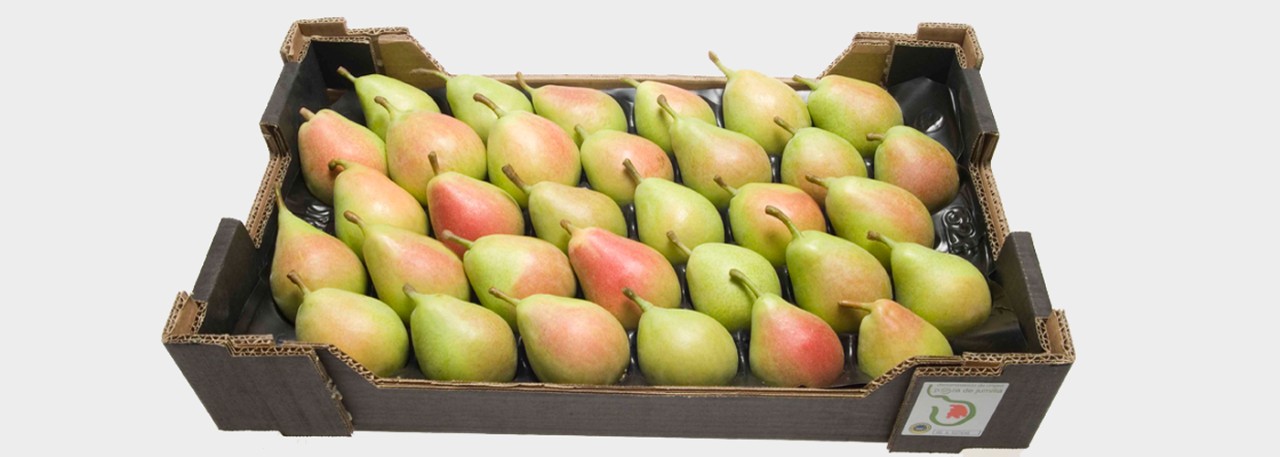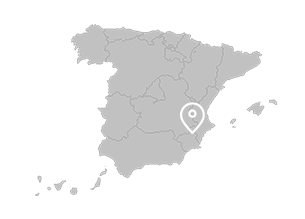.png.transform/rendition-xs/image_image%20(1).png)
Pera de Jumilla PDO
Fruit of the species Pyrus communis L., from the Ercolini variety, categories Extra and I, destined for fresh consumption.
Tasting notes
Very light, sugared flavor, slightly perfumed and with an excellent flavor.
Other notes
Soft, juicy flesh, yellow on a green background, with a reddish coating on the sun-facing side due to the large quantity of sunlight received by the fruit. The main differences between this pear and pears from other regions is that it has a superior level of sugars, as well as earlier ripening and increased firmness and caliber. The fruits are whole, healthy and clean, with no visible foreign bodies, and lacking in humidity and strange aromas or tastes. Extra category pears have a diameter exceeding 58 mm (2.28 in), and category I fruits have a diameter of more than 52 mm (2.04 in). In terms of acidity, the fruit must have a ratio of 1.5 g (0.03 oz) of malic acid per liter. Soluble solids must have a value of over 10.5º Brix.
Production / Processing method
The product is obtained by following techniques that respect the environment. The vegetable material has a phytosanitary passport, and is adapted to local conditions. Both trimming and harvesting are manual, and the latter is carried out in two phases, avoiding the hours when the sun is at its strongest. Pears are collected at the perfect point of ripeness, and only when determined so by the control body.
To evaluate the ripeness, parameters such as caliber, skin color, pip color, firmness and sugar levels are analyzed. During harvest time, the fruit is delicately plucked from the tree, with pressure applied at the point where the fruit is attached and an upwards plucking movement used, to avoid damage to the stalk. No more than 8-10 hours may pass between harvesting and the delivery of the fruit to the handling plants. When received at these plants, the crop, plot of land from where it came, the name of the producer and the date of entry are all identified. The trucks are weighed and samples of the fruit are taken, so that quality controls can be carried out. The pears are then transferred to cooling rooms.
Geography / Relief and climate
This is a valley zone, with limey soils and crust formation, located between limestone mountains. The limey soil and sandy loam land, with a high pH, is an important, unique factor for cultivation of these pear trees.
Its steep landscape, with an average altitude of 480 m (1,574 ft) above sea level, is home to numerous mountainous formations from northwest to southeast, with broad valleys which catch the midday sun, providing optimal sun exposure for pear cultivation.
The climate in the protected geographical zone has a significant influence on the quality of the product, providing it with early ripening, greater caliber and improved flesh consistency, as well as its characteristic red coating. The Jumilla climate is particularly influenced by its proximity to the Mediterranean, with a warm climate but sufficient altitude so that the low winter temperatures can meet the need for cold involved in pear cultivation. The climate has no spring frosts and has low rainfall in this period - if this were not the case, the flowering and setting of the pears would be adversely affected. The dominant winds are from the northwest, dry and warm at dusk, allowing any diseases which may affect the fruit to be controlled.
Planting is carried out in valleys which face the midday sun, thus providing high levels of light and greater solar rays. High average temperatures (15 ºC (59 ºF) on average), with no significant nocturnal contrasts and a lack of Spring frosts, favor the rapid growth of the fruit. During the ripening process, the high number of hours of sunlight and increased solar radiation are the main factor in ensuring that Jumilla pears have high soluble solids content, with their sugar content being the main measure of internal quality.
In addition, the traditional practices (unique to the area) represent a link between the specific characteristics of these pears and their geographical surroundings. In this way, the manual trimming and pruning ensure that the amount of pears on each tree is adequate, thus increasing their caliber and sweetness without destroying their structure and balance.
Regulatory Council
Consejo Regulador de la DOP Pera de Jumilla
Plaza de la Alcoholera 3, 2ª planta
30520 Jumilla (Murcia)
Tel: (+34) 646 140 282
peradejumilla@gmail.com
Sources:
The main differences between this pear from others is that it has a superior level of sugars, as well as earlier ripening and increased firmness and caliber.


- /content/dam/en/icex-foodswines/images/products/fruits---vegetables/pera-de-jumilla-pdo/Pera%20de%20Jumilla%20PDO%20carr1.jpg
- /content/dam/en/icex-foodswines/images/products/fruits---vegetables/pera-de-jumilla-pdo/Pera%20de%20Jumilla%20PDO%20carr1.jpg

Jumilla (Murcia)
